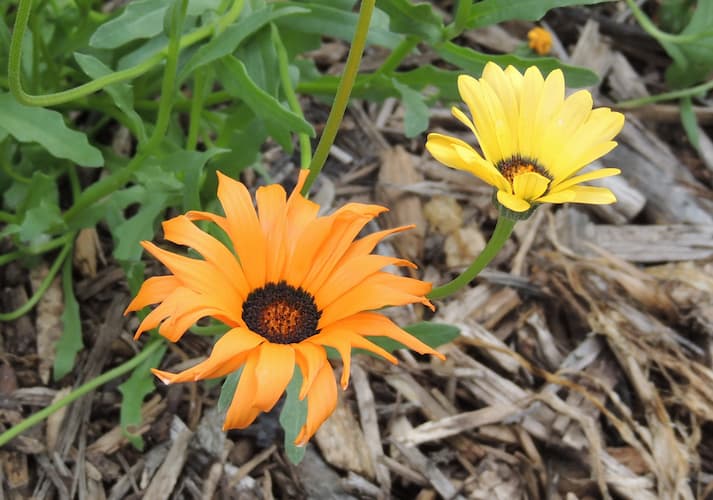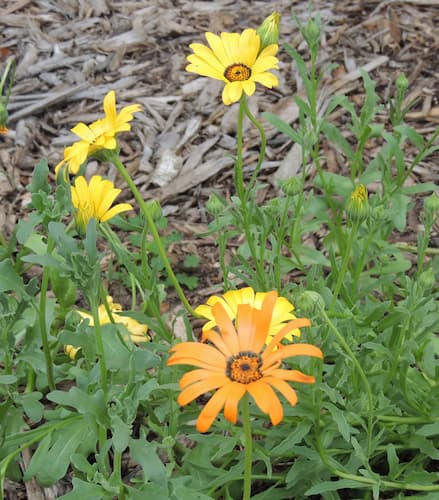How to Grow African Daisy

African Daisy is an easy-to-grow annual flower with about 70 varieties. A few varieties are perennials. It is native to South Africa and Asia. The plant grows quickly. Growing African Daisies will reward you with the first blooms in just 50 to 60 days. Soft colors include white, orange, yellow, and apricot.
Grow African daisies in your annual flower beds, for a bright and cheerful appearance. Also, these flowers look great in containers and pots on your patio or deck. But make sure to place the container in a sunny location. In the flower garden, place them towards the front.
Other Names: African Daisies have lots of names. They include Cape Marigold, Star-of-the-Veldt, Dimorphotheca, Barberton Daisy, Blue Eyed Daisy, Veldt Daisy, Transvaal Daisy, Gerbera Daisy (this is not a Gerber Daisy)
Are African Daisies Edible?
Are you hungry!? African daisy buds and flowers are edible. It has a slightly sweet taste. Use it as a garnish or add it to salads. The leaves are also edible. But, it has a bitter aftertaste. Use the leaves cooked with other vegetables or as a potherb.
Some people preserve the buds in vinegar for later use as a substitute for capers.
African Daisy Plant Specifics
Flowers Bloom: Spring to Fall
Flower Colors: Apricot, orange, pink, purple, yellow white
Days to Bloom: 50 – 60 days
Plant height: 12″ – 18″
Sunlight Needs: full sun
Ideal Soil pH: 5.0 – 5.5.
Hardiness Zones: 10 – 11
Toxicity: None
Native to: Africa, Asia
Annual, Dimorphotheca
African Daisy Plant Propagation
African Daisies are grown from seeds. Directly sow seeds into your flower garden after all risk of frost has passed. Or start plants indoors eight to ten weeks before the last frost date in your area. African Daisy seeds need light to germinate. So spread or place the seeds on top of the soil. Do not cover them with soil. Then, water them lightly. Because the seeds are on top of the soil, check the moisture regularly.
Use of a germination mat is not recommended as the seeds do not like heat.
The ideal plant spacing is 10″ apart. The plants will tolerate a little crowding.
Days to Germination: 10 – 20

How to Grow African Daisy Flowers
Growing African daisies is easy. Grow them in full sun. The plants tolerate partial shade but will produce fewer blooms and the plants may become spindly.
The plants grow well in rich, sandy, loam, light, well-draining soil. Mix in a generous amount of compost at the planting site. You can also add well-rotted cow or horse manure. However, do not use hot, raw manures. Add a general-purpose fertilizer when planting, then once a month after that. For plants grown in containers of flowerpots, apply a liquid fertilizer regularly.
The plants are slightly drought resistant. For the best results, keep the soil moist, not wet. Water only during dry periods. Avoid getting the leaves wet, as these plants are susceptible to fungal disease.
Weed frequently early in the season. Apply mulch to keep the weeds down.
The flowers open in daylight and close up at night. They also may close in cloudy, overcast weather.
The plants are good re-seeders. Plant them where they can drop their seeds and grow undisturbed for years.
Deadhead spent flowers to produce a continuous bloom into the Fall months.
Also, See:
Plant Problems – causes and cures
African Daisy Insect and Pest Problems
Aphids can be a problem. Apply insecticides or repellents, as needed. Animal pests do not bother them.
African Daisies Plant Disease
African Daisy plants can get fungal diseases. Keep leaves and stems dry. Plant disease may also occur in humid or rainy weather.
Aside from fungal disease, the lant grows trouble-free.
Apply fungicides as needed. You can also opt to apply a fungicide when humid weather is forecasted.
Please support our site. Shop for:
- rmmatthews100@hotmail.com
- 585-721-6528
- Rochester, NY
©1999-2024 GardenersNet.Com, All Rights Reserved

